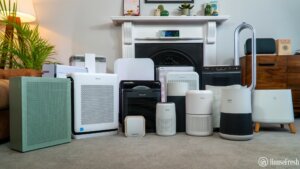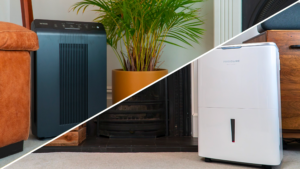Knowing its whole story is essential if you’ve been considering buying an air ionizer. This includes the potential dangers of air ionizers.
While ionizers can effectively remove certain VOCs from your environment, they also generate fine particulate matter and other VOCs as a byproduct. Understandably, the build-up of these toxins in your home could be more potent than what already exists. This means you could end up making it more toxic in there.
In this article, we’ll be looking at how air ionizers work, why they’re dangerous and the claims that have been brought against them.
Let’s get into it!
Ionic air cleaners are devices that work by emitting negative ions into your environment.
As everything around you comprises either positive (cation) or negative (anion) ions, the anions from the ionic air cleaner are attracted to and attached to cations — creating an electrical charge.
The cations in your environment include any pollutants that m air, such as tobacco smoke (though not larger particles). In particular, ionic air cleaners will not effectively remove pollen, dust and pet dander.
As the cations and anions are attracted to one another, this causes them to “clump” together, making them unable to stay in the air.
They fall to surfaces, such as your furnishings and can be cleaned up from there. Surfaces where the particles could land, could include
- Walls and ceilings
- Tabletops, floors and other surfaces
- Curtains, carpets, rugs and other furnishings.
Some ionic air cleaners also have metal plates inside the device to collect the pollutants that have fallen out of the air. They’ll need to be wiped clean periodically.
It’s also important to note that while ionizers are a form of air purifier, they are not the same thing. However, some air purifiers may have ionizers or ionizer functions built in.
Ionizers are also far more effective at water purification than air purification.
Reasons why ionic air cleaners are dangerous
While ionic air cleaners can remove certain things from your home, this is at the risk of introducing other unwanted toxins and pollutants.
Here are three main reasons why having an ionic air cleaner in your home is dangerous.
1. Ionic air cleaners create ozone
You may have heard of ozone in terms of the protective layer that protects us from the sun’s UV rays, (good ozone). Unfortunately, “bad ozone” — also known as “smog” — is incredibly harmful to your health if inhaled.
Ionic air cleaners generate ozone as a by-product. The EPA has classed ozone as toxic, noting that it can cause lung damage, amongst other respiratory-related issues. In some cases, it can even cause death.
In addition to that, when ozone reacts with certain chemicals in your household (including carpet cleaning fumes and cooking oil!), it produces formaldehyde.
- Throat irritation
- Chest pain
- Coughing
- Shortness of breath and difficulty breathing
2. Ionic air cleaners create VOCs and ultrafine particles as a by-product
Ionic air cleaners create certain VOCs as a by-product, as this 2008 study published in the academic journal Atmospheric Environment, found. The researchers of this paper found that both formaldehyde and ozone increased while running an ionic air cleaner in a controlled space.
This was backed up by this Building and Environment study, where researchers concluded that harmful VOCs increased when ionizers were run. However, they conceded that certain other VOCs decreased, but this was offset by the harmful effects of the VOCs that increased.
Furthermore, this 2021 study published by The Hong Kong University of Science and Technology found that air ionizers could potentially damage people with asthma due to the ultrafine particles emitted by running air ionizers.
3. Ionic air cleaners aren’t effective at removing larger particles
The EPA has noted that ionizers are not very good at removing certain larger particles, including pollen, dust, gasses and odors. This study from 2008 also found that home ionic air cleaners generally couldn’t affect levels of particulate matter in your home. Instead, they would need to be much more powerful, which doesn’t exist in the current market.
That means that, in the long run, current ionizers do next to nothing for the air health of your home.
This evidence-based study from the National Library of Medicine found that ionizers were ineffective in controlling the spread of air-borne and droplet-spread viruses.
Danny’s verdict: HouseFresh doesn’t recommend ionizers

A timeline of controversy and lawsuits against ionic air cleaners
The controversy surrounding ionic air cleaners has been ongoing, especially since the pandemic.
🗓️ 2002-2003
- Consumer Reports published two articles in 2002 and 2003, stating that Sharper Image’s Professional Series Ionic Breeze Quadra SI737 SNX was an ineffective air cleaner with “almost no measurable reduction in airborne particles”.
🗓️ 2005
- Sharper Image sued the Consumers Union, but had their case dismissed, as they had not “demonstrated a reasonable probability that any of the challenged statements were false.” Sharper Image was then forced to reimburse legal fees to the Consumers Union, totalling around $525,000 in 2005.
- That same year, Consumer Reports published another article about the dangers of ionic air cleaners regarding their ozone emissions, which CNN reported on.
🗓️ 2008
- Sharper Image then faced another round of lawsuits from various consumers and shareholders and finally filed for bankruptcy in 2008 after steadily declining sales for several years and negative publicity around their Ionic Breeze device.
Despite this, it wasn’t until 2021 that people started seriously discussing the dangers of ionic air cleaners again.
🗓️ 2021
- Global Plasma Solutions started marketing ionizers to schools, claiming that they would be able to reduce Covid by over 99%. However, the testing they carried out was in a tiny chamber, where they fired 27,000 ions per cubic centimeter at the virus. The actual devices that were sold did not equate to the spaces they were installed in.
- Boeing even tested air ionizers for their commercial airplanes, similar to the ones being marketed to schools. It was concluded that they were ineffective at providing disinfection. However, Global Plasma Solutions cited this report as evidence that their devices were effective.
- Aa group of engineers and scientists who specifically deal with filtration systems published an open letter on Medium. Their letter appealed to the schools and administrators who had been installing ionizers in schools, pointing out that they were unproven to work and emitted dangerous ozone as well.
- Global Plasma Solutions filed a lawsuit against one of the 12 experts who penned the letter.
- KHN reported about the various companies who were cashing in on the pandemic and pushing their ionizer products as solutions to removing Covid from school environments. So did PBS, NBC, CNN, and Wired.
- A class action lawsuit was filed against Global Plasma Solutions for misleading consumers about the effectiveness of their air ionizer products.
🗓️ 2022
- Global Plasma Solutions also filed a lawsuit against Elsevier — a reputable global publisher of scientific articles and studies — for libel over their 2022 study, where they had also investigated the dangers of ionizers.
- This Tweet from Jim Rosenthal highlighted that this study was peer-reviewed and concluded that ionizers did not reduce particulate matter in your environment. However, Global Plasma Solutions demanded that the article be retracted.
🗓️ 2023
- Even Smart Air, an air purifier device company, said in a Tweet when asked about the increased risk of ionizers, “maybe the ionizer could increase risk because (1) ozone + VOCs could inflame the respiratory tract and maybe that increases susceptibility to viruses? (2) Ionizers cause particles (viruses are particles) to stick to the lungs. FWIW, I wouldn’t use one myself.”
- One law firm is currently investigating different companies that make ionizers, so there won’t be the last lawsuits we see surrounding these devices.
Final thoughts
While plenty of companies out there are touting the benefits of air ionizers in purifying your air, there’s much more evidence around the harmful effects these have on your environment.
If you’re considering an air ionizer, be aware that its ability to remove harmful contaminants from your environment is minimal. The evidence that they are effective is either incredibly skewed or non-existent.
Instead, the production of ozone and harmful VOCs such as formaldehyde should make you think twice before you purchase an ionizer for your home.
SOURCES
- Alkhadra, M.A. (2022). Electrochemical Methods for Water Purification, Ion Separations, and Energy Conversion. ncbi.nlm.nih.gov
- Barber, G (2021). The Ionizer in Your School May Not Do Much to Fight Covid. wired.com
- Barrett, S. (2005). Court Dismisses Sharper Image Lawsuit Against Consumers Union. quackwatch.org
- Center for Inquiry. (2004). Sharper Image Corporation v. Consumers Union Of United States Inc. centerforinquiry.org
- Cheng, Q. (2021). Air Ionizers Case Study. iopscience.iop.org
- Court Listener. (2021). Global Plasma Solutions Inc v. D Zine Partners LLC Complaint — Document #1. courtlistener.com
- Court Listener. (2021). Global Plasma Solutions, Inc. v. IEE Indoor Environmental Engineering. courtlistener.com
- Justia. (2022). Global Plasma Solutions, Inc. v. Elsevier Inc. et al. dockets.justia.com
- Li, J.T.C. (2021). Ozone Air Purifiers: Can They Improve Asthma Symptoms? mayoclinic.org
- Licht, S et al. (2020). Use of Bipolar Ionization for Disinfection Within Airplanes. boeing.com
- National Library of Medicine. (2005). Air Cleaning Technologies: An Evidence-Based Analysis. pubmed.ncbi.nlm.nih.gov
- Offermann, F.J. (2020). Beware The COVID-19 Snake Oil Salesmen Are Here. iee-sf.com
- Ortega, B. (2021). Efficacy of Ionic Air Purifiers Investigation. classlawdc.com
- Pauly, M. (2021). Hundreds of Schools Are Using This Air Purifier to Fight COVID. A Lawsuit Says It Releases Toxic Chemicals. motherjones.com
- Przybyla, H. (2021). Federal Officials Seek Better Rules About Schools’ Indoor Air Quality. nbcnews.com
- Qatson, R. (2022). Scientists Sued for Criticizing COVID-19 Air Purifiers. skepchick.org
- United States Environmental Protection Agency. (2023). Ground-Level Ozone Basics. Epa.gov
- United States Environmental Protection Agency. (2023). Health Effects of Ozone Pollution. epa.gov
- United States Environmental Protection Agency. (2023). What Are Ionizers And Other Ozone Generating Air Cleaners? epa.gov
- Weber, J, Jewett, C. (2021). As Schools Spend Millions on Air Purifiers, Experts Warn of Overblown Claims and Harm to Children. khn.org
- Zaatari, M. (2021). Open Letter to address the use of Electronic Air Cleaning Equipment in Buildings. medium.com
- Zeng, Y et al. (2021). Evaluating A Commercially Available In-Duct Bipolar Ionization Device For Pollutant Removal And Potential Byproduct Formation. sciencedirect.com






